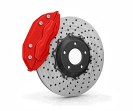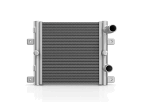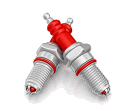Like all we do is chase down coolant leaks. Maybe that has something
to do with weather patterns and lai^e swings in ambient
temperature. It may also relate to how well customers
lake care of their vehicles, how often they take them in
for service, or the replacement parts they use. Either way these re
pairs need to be made, and finding out the cause needs to happen
quickly and accurately.
Sometimes that's not too hard to do if the leak is obviously
coming from a blown hose, corroded fittings or a loose clamp connection. A thorough check of the engine, radiator and remaining
hoses and fittings are still a top priority, but getting that main problem fixed is usually quick and easy.
That is, as long as the parts are available. 1 ran across a lowmile
e Cherokee recently that should have been a cake job (it
needed a new radiator due to internal clogging and major extemal
fin corrosion, thanks to PennDOT's road deicing brine solution),
but ended up taking two days and requiring me to graft together an
upper radiator hose out of two "almost right, but not quite" hoses.
Although it was an original, stock 2000 XJ, it turned out to be
one of the rarest combinations ever made by Chrysler a left-hand
drive, 2-door, 4-wheel drive, 4-cylinder, manual transmission with
air conditioning. In fact, production numbers on this setup were
so low that neither of the most well-known hose manufacturers
makes a replacement! See Figures 1,2.
Then you have those leaks that seem to come and go, because
that's exactly what they do. I'm referring, of course, to tank leaks
that show up only when conditions are right. About 90% of auto
motive radiators today are made of an aluminum core with plastic
side tanks that are crimped together with a gasket during manufacture.
Mowever, that crimp connection can only be made so tight (too
tight and the tank can crack, too loose and it leaks), which means
tlie gasket has to take up the difference. Very small crimp leaks will
sometimes come and go with ambient temperature and stop leak
ing much of the time when the system warms up. These nuisance
leaks may only drip once in a while, but the gasket will eventually
succumb to cycling and corrosion, requiring replacement
of the radiator assembly.
If the tank is completely blown, caused by too much system
pressure, you'll have to check for a bad radiator cap, debris causing restricted coolant flow, or even a blown cylinder head gasket
Sneaky leak Sometimes these elusive small leaks take a bit more detective
work to find. Take for example the heater control valve that leaks
only when it's in llie OFF position. This is something technicians
don't always think about checking, since the position of the valve
is often not the determining factor (Figure 3).
Figure 1: This hose wasn't leaking yet, but w/tfi cut
matits and thread weaves showing through, it's a disaster waiting to happen.
Figure 3: This valve was leaking through the shaft seal
when in the OFF position, but because it defaults to ON
(OPEN) when there's no vacuum, the leak never showed
during a pressure test A sneaky leak indeed!
o
Figure 2: The original looked like a typical upper
radiator hose, but no replacements are available in
the aftermarket I've had to graft two "close enough'
replacements together to make it work.
Keep this in mind if you consider reusing recently drained
engine coolant: if it's been sitting around for several hours,
exposed to the atmosphere (not covered up), it's likely that
much of the water component has evaporated, which concentrates the mixture. And contrary to popular belief, even
some of the giycol will evaporate (albeit at a much slower
rate), changing the concentration level yet again,
if you're planning to reuse (for example, if you recently
flushed and refilled a system with a new coolant mixture),
it's best to pour it into a clean, "used coolant" container right
away after it's been drained out, to retain its consistency.
Also, make sure to filter or strain the coolant before reuse,
and measure its freezing point with a refractometer.
March 2019 •action Finding coolant leaks
The one we repaired was vacuum operated and leaking through the
shaft seal, but only when the valve was in the OFF position (not allowing
coolant to flow through the valve to the heater core). Since the valve's de
fault position is to be ON (OPEN) when there is no vacuum applied (such
as when there's a system fault or if the engine isn't running), the leak never
showed up during a pressure test (which can only be done with the engine
off, relatively cold and when the system is not self-pressurized).
The reason it's so difficult to find some of these come-and-go leaks
is because coolant dries up, and we need to use something that will stick
around long enough^ to enable us to find it. This is where dye can really
help.
Ifs just another way to dye
We're all familiar with using A/C dye to help detect current or future refrigerant leaks. It's easy to use, since you just have to add the right
amount (and type) of dye to the system, let it circulate so it mixes well with
the oil and refrigerant, and tlien search for a leak using a UV (ultraviolet)
light. It may not show every kind of leak, and sometimes dye takes a while
before you can see it, but once you do it's a positive indication of where the
leak is at. See Figure 4.
But using dye isn't limited to A/C systems. Various dye formulations
exist that make it possible to dye many other fluids, for example, engine








